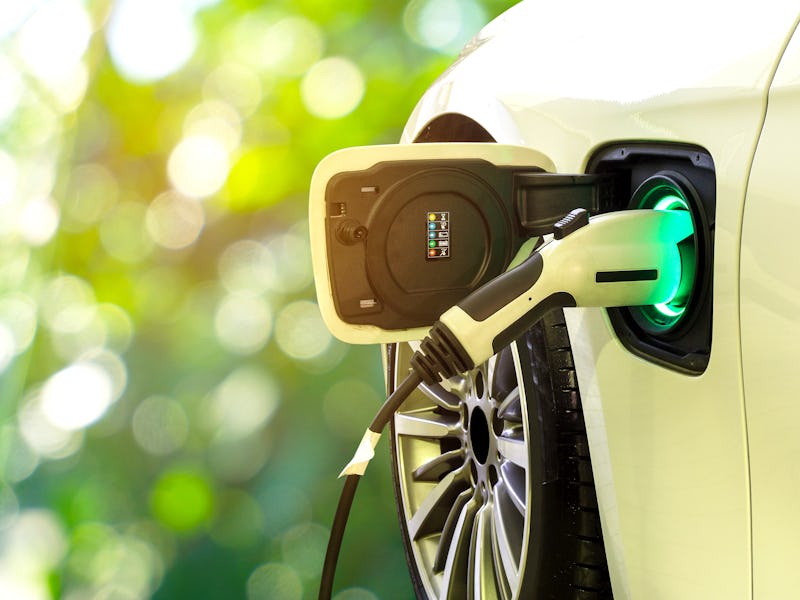Electric cars could charge in record speeds thanks to a new breakthrough
The future of electric cars may become a lot more accessible.

Want to switch to an electric car, but worried about range anxiety? Thanks to a new scientific breakthrough, it could soon prove a thing of the past.
Researchers at Penn State have developed a means to charge a lithium-ion electric car battery in just 10 minutes, ready for another 200 to 300 miles of driving. The research, published Wednesday in Joule, shows the technique could work while maintaining 2,500 charge cycles — or the equivalent of 500,000 miles of travel.
It could help electric vehicles reach a broader audience. Statista shows the number of battery electric vehicles in use globally increased 50 percent year-over-year last year, jumping from 1.9 million in 2017 to 3.3 million in 2018. But that’s a small fraction of the total number of cars on the world’s roads, estimated at over one billion in 2015 by Bernstein. As road transport is responsible for an estimated 16.5 percent of global emissions, switching to a cleaner means of mobility is critical to meet climate change targets.
Enabling batteries to charge faster could help with the transition. OVO Energy, who asked 2,000 Brits in October 2019 why they hadn’t bought an electric car, found 43 percent cited the time it takes to charge. When Volvo asked 1,510 American electric car drivers last year for their most-wanted feature at public chargers, 48 percent said they wanted to pay more to double the charging speed. Porsche CEO Oliver Blume predicted earlier this month that electric cars could offer fast-as-fuel charging within the next 10 years.
“Fast charging is the key to enabling widespread introduction of electric vehicles,” Chao-Yang Wang, professor of chemical engineering and professor of materials science and engineering at Penn State, said in a statement.
Ions in a battery flowing from the cathode to the anode.
Fast charging electric cars: how the team’s breakthrough works
The problem with charging a lithium-ion battery at speed is that they degrade at ambient temperatures under 50 degrees Fahrenheit. That’s because lithium ions start to spike on the carbon anodes instead of smoothly inserting themselves.
The team’s breakthrough was in heating up the battery to reduce these spikes. They created a battery that could charge in 15 minutes at 50 degrees Fahrenheit. They then discovered that, if they pushed the battery to 140 degrees, they could charge in just 10 minutes.
“Taking this battery to the extreme of 60 degrees Celsius (140 degrees F) is forbidden in the battery arena,” said Wang. “It is too high and considered a danger to the materials and would shorten battery life drastically.”
The team used a thin nickel foil with one end attached to a negative terminal and the other to a third terminal outside the cell. Electrons flowing through the foil causes resistance heating in the foil, which makes the battery warm up.
The battery could avoid heat degradation through rapid cooling after the charge was complete. This would use the car’s cooling system to bring it down to safer temperatures.
Tesla Roadster.
Wang’s team is not the first to heat a battery to improve charge times. Tesla announced a similar system in March that would heat the battery to speed up charge times by up to 50 percent. Paired with a new 250-kilowatt supercharger station, the company was able to drop the average charge time down to 15 minutes.
Cutting the times even further could help convince consumers that electric vehicles are the way forward. Instead of worrying about whether an electric car can make the journey on a single charge, consumer attention could turn to taking short breaks during a trip, trips that last a similar length to a visit to the gas station.
“The 10-minute trend is for the future and is essential for adoption of electric vehicles because it solves the range anxiety problem,” said Wang.
Read the summary below:
Adding a 200-mile range in 10 min, so-called extreme fast charging (XFC), is the key to mainstream adoption of battery electric vehicles (BEVs). Here, we present an asymmetric temperature modulation (ATM) method that, on one hand, charges a Li-ion cell at an elevated temperature of 60°C to eliminate Li plating and, on the other, limits the exposure time at 60°C to only ∼10 min per cycle, or 0.1% of the lifetime of a BEV, to prevent severe solid-electrolyte-interphase growth. The asymmetric temperature between charge and discharge opens a new path to enhance kinetics and transport during charging while still achieving long life. We show that a 9.5-Ah 170-Wh/kg cell sustained 1,700 XFC cycles (6 C charge to 80% state of charge) at 20% capacity loss with the ATM, compared to 60 cycles for a control cell, and that a 209-Wh/kg BEV cell retained 91.7% capacity after 2,500 XFC cycles.